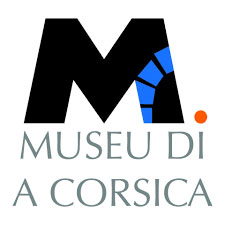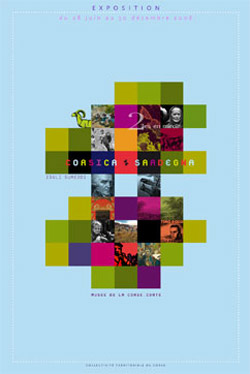Two islands in mirror
We had to wait until recent years, with the establishment of European programs (INTERREG), the status of autonomy given to Sardinia at the end of the Second World War and the recent law of decentralization (1992) for Corsica, to note a resumption of relations, probably still too fragile, for two islands that have ignored each other for so long.
The situation of these territories reveals the diversity of Mediterranean communities understood within a common base and proposes to question the construction of the identity of a people. It is resolutely on these differences which form system in the Mediterranean context, between terrestrial fragmentation and maritime connectivity, that the bias of the exhibition Corsica-Sardegna is registered.
Corsica and Sardinia, sister islands or neighbors?
Corsica and Sardinia are two twin islands, says a Sardinian song. The reading of a map of the western Mediterranean shows that they form the same geographical and geological entity, only separated of a dozen km by the strait of Bonifacio. Mythological accounts also bring them together: in ancient authors, especially in the cycle of Aeneas, opened by Virgil, they are often linked. Occupying a strategic position in the Mediterranean, they underwent the same historical vicissitudes under the Roman, Pisan and Genoese dominations. But their destinies diverged in the 18th century. Strong of their geographical and natural proximity, Corsica and Sardinia will develop a history and different cultural practices. So close and so far.
First of all, geographically speaking, Corsica has some 50 peaks reaching more than 2000 meters; Sardinia is three times bigger and offers a landscape of plains and hills. 300,000 inhabitants in Corsica and more than 1,700,000 in Sardinia, these figures alone suggest a different history and societal organization: the two large islands of the Tyrrhenian Sea are less similar than they seem.
The rediscovery of the Mediterranean
However, the cultural and historical bases are identical: the ways of life are close, with a strong pastoral practice and recurrent banditry, a common backdrop, composed of techniques and agrarian landscapes, as well as an ideological and cultural horizon. But the practices and their evolutions differ: the two islands have never developed intense economic and social relations and have rubbed shoulders in a mutual ignorance. The refusal of the sea and its dangers (epidemics, famines, barbarian raids…) has kept them apart, even more the relief has enclosed and isolated the communities. Corsica and Sardinia, similar in their origins but separated by their destinies, will finally benefit from a common lighting in the context of the rediscovery of the Mediterranean.
After the first illustrated journeys, the photography will testify of these societies which appear, in spite of them, archaic. The photographs from the work of Clifton Adams during his Mediterranean tour for the National Geographic in 1922 translate the exotic approach of Corsica and Sardinia, revealing aspects of certain populations that had never been seen before: the highlighting of original customs and mores within more or less hostile landscapes, gives the measure of the evolution of the ways of life of these islands. The approach of Ange Tomasi, a Corsican photographer, is different: it gives the measure of a world that flees. The photography of the 1920s in the Mediterranean accompanies the phenomena of colonization and industrialization of societies and responds to the need for images created by modern society and the tourism industry that is developing irrevocably. A mutation is taking place within these societies on borrowed time.
The “Island of beauty” and the “Island of silence”: representations
The representation of the islands takes all its measure with the economic evolution of the XIXth and XXth centuries, opening the world to the Europeans and making the Mediterranean a space of exotic travel and discovery of the other. An image specific to each island gradually takes shape. Corsica becomes the romantic island of heroes and leads us into an artistic universe dominated by landscapes and an omnipresent wild nature; Sardinia, rich in its cultural heritage, is identified with its great ancient scenery and its people. The Italian artist Guido Colucci, for example, made a precise study of the populations to reproduce with precision the traditional clothing, a real social symbol, with an artistic and educational purpose.
In Corsica, rare are the testimonies of a traditional costume; from the Restoration, the black, so dear to the Romantics, ceasing to be a noble privilege, imposes itself in the 19th century. Whereas in the following century, the daily agropastoral activity makes useless, if not, forbidden, any elegance, the folklorists seize the last stake, that of the widows of 1918, to make a uniform of it to spectacular ends. The supposed “Corsican costume” becomes a tourist attraction. In Sardinia, the costumes and the rich in colors adornments are strong local traditions: the wearing of the complete traditional clothes remains sometimes practiced by a minority, in a movement at the same time social and cultural of construction of the local identity that brings the individuals to recognize themselves. Each village has its own costume.
In this context of ethnological emulation, the Mediterranean appears as the central place of understanding of societies and a real laboratory where we can admire the greatness of antiquity and observe the almost wild communities, like that of the shepherds, of these islands that have remained outside the movement of history. Here is the testimony of Franco Cagnetta, one of the first to have given voice to the Sardinian people, evoking his meeting with the old shepherds of the Barbagi: with their hard, scaly faces and yet imbued with a strange gentleness […] They almost all remind us of figures from the Old Testament: with their white eyebrows that descend very low over their eyes, their moustaches, their long curly beards that fall in neat folds to the middle of their chest.
The intellectual and artistic awakening in the two islands
If the beginning of the XXth century is marked by the ethnological and geographical rediscovery of the Mediterranean, an intellectual and artistic awakening takes shape in Corsica and in Sardinia, as the echo of the “national” spirit, led by young artists who want to tell the fabulous soul of the island which saw them being born, as Giuseppe Biasi in Sardinia. In Corsica, island artists have largely participated in the creation of “iconic” images of Corsica and the promotion of a strong and typical image of their island. From the beginning of the 1900s, painters leave their studios and the landscape becomes one of the main genres of their activity, reflecting the society and lifestyles of the time. Léon Canniccioni painted all the typical places and characters of Corsica: fishermen, shepherds, farmers… He conveyed the image of a landscape that was both rough and original, but always of a noble beauty. He paints the ritual activities: harvest festivals, religious traditions, burials and processions. The insular magazines and publications of the years 1920-1930 appear as first choice supports of the Corsican artistic expression.
But other artists were also interested in the island: more than 400 painters, including nearly 80 foreigners, arrived in Corsica at that time; among them, Paul Saïn, Camille Boiry, then André Strauss and Auguste Bouchet, were to give it an engaging vision. This approach of Corsica and of the life in Corsica is confirmed by Rosa Luxemburg who writes in January 1917:
I intend to take you to Corsica… Europe, at least modern Europe, is forgotten. Imagine a vast and heroic landscape with mountains and valleys with severe lines… […] And on all this landscape reigns a silence of the beginning of the world… […] And the people you meet are in agreement with the landscape. At the bend in the mountain path, a caravan suddenly appears – the Corsicans always walk one behind the other, in a long convoy and not in a group like our peasants…
Between geographical and ethnological studies, faithful or stereotyped representations, the Corsica-Sardegna exhibition shows the two islands from two distinct angles: the view of the outside world on this Mediterranean space (in particular thanks to the photographic report of the National Geographic Magazine with 63 photographs of Corsica and Sardinia); the introspective view of the islanders (through 30 photographs by Ange Tomasi and Guido Costa intended to serve as anthropological documentation or the work of Guido Colucci).
The exhibition focuses on the twentieth century, and more particularly on its first half, because the period contains several elements of understanding the subject. The economic and social evolution transforms then deeply Corsica and Sardinia. And by a rather logical effect of pendulum, these changes involve the study of the traditional societies in way of disappearance.
One of the most convincing examples is undoubtedly the rediscovery of traditional Corsican and Sardinian polyphonic music and the current craze that it arouses, in a movement of rehabilitation of this musical heritage since the 1950s. These vocal traditions symbolize, for both Sardinians and Corsicans, social cohesion and a resistance of cultural minorities to the phenomenon of globalization. They are also tangible proof of linguistic and musical exchanges between the two islands, which, although tenuous, have existed since prehistoric times.
If the twentieth century has come to complicate a little more the relations of the neighboring islands (the claims of Mussolini’s Italy on Corsica and then the Italian and German invasion of the Second World War build a real border), this exhibition is the irrefutable proof of a change in progress, of a slow rapprochement, silent but irresistible. The destinies of Corsica and Sardinia are finally taking the same path in the 20th century, that of the right balance between production and tourism, economic dynamics and heritage preservation. At the southern margin of the European Union, but in the heart of the western Mediterranean, Corsica and Sardinia remain moored to their respective nation-states; their future depends on a closer relationship with the Mediterranean Arc.
Curator: Pierre-Jean Campocasso, heritage attaché at the Museum of Corsica, doctor in History.
Scenography: Yves Kneusé
Realization: Museum of Corsica (Direction of the Heritage, CTC)




